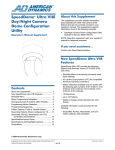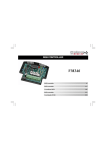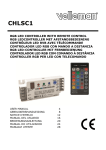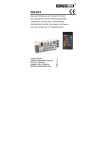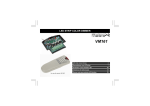Download Velleman CHLS5RGB/1M LED lamp
Transcript
LED STRIPS LED strips are a new generation innovative lighting product with which spectacular lighting effects can be created in an easy way. They offer many advantages including small dimensions, low heat generation, higher energy efficiency, more saturated colours and easily controllable. As you will notice there are countless applications for LED strips. Velleman offers a full range of LED strips and accessories; this overview should give you a good impression of what is possible and how to implement your own personalized lighting application. Generally LED strips can be divided into 2 main groups: flexible and rigid (non‐flexible) strips. In this tutorial and selection guide we will only focus on flexible LED strips as they are most frequently used. Selecting the right strip for your application is a 5‐step process: 1) Select a strip according to the place where it will be used (indoors, outdoors) 2) Determine the length and the desired number of LEDs per unit of length. (length in meters and desired nr. of LEDs per meter) 3) Select the colour (single colour or RGB) 4) Select a suitable power supply (voltage and power) 5) Select a suitable controller (dimmable, remotely controlled, DMX controlled,...) 1) Select a strip according to application area Mainly there are 3 types of LED strips which can be used in different environments: Bare strip (no protection against dust or water) Ideal for indoor applications, e.g. in or under cupboards, stairs, indirect lighting applications … Silicon covered strip (IP67, weatherproof) Suitable for use in humid locations such as bathrooms and for use outdoors, for example on garden furniture or accent lighting on houses and buildings... Silicon sleeved LED strip (IP68, fully waterproof) This strip is fully encapsulated by a silicon sleeve and is suitable for use in extremely humid environments such as swimming pools, saunas, or outdoor use where direct contact with rain or water is unavoidable. 23.04.2010 1 ©Velleman nv Note: Originally the PCBs holding the LEDs were copper coloured. New generation LED strips have white coated PCBs, which give a more uniform light distribution. 2) Determine the length and the nr. of LEDs per meter Standard LED strips have a length of 5m and contain a number of series and parallel connected LEDs. This design enables you to cut the strip every fixed number of LEDs; the places where the strip can be cut are clearly marked on the strip. Cut‐off parts of the strips are not wasted as it is possible to solder new power supply wires to these cut‐off parts. Also LED strips may have a different amount of LEDs per meter. Most common are LED strips with 30 or 60 LEDs per meter, thus a standard length 5m LED strip is available with 300 or 600 LEDs. Which amount of LEDs is better for your application can be determined by following factors: More LEDs per meter: More light output, more uniform light distribution – better for direct lighting Higher current/power ratings which has impact on heat, total length, power supply and controller Less LEDs per meter: Less light output, more dispersed light distribution – especially suitable for indirect lighting Lower current/power ratings which has impact on heat, total length, power supply and controller Is it possible to interconnect LED strips to create longer distances? Yes, but keep following limitation in mind: Each LED strip will consume the same amount of power. If LED strips are interconnected the total power and thus current trough the LED strips increases and this current is limited by the design of the strip (check the LED strip data sheet for ratings and limitations). Example: You need a total LED strip length of 20m blue LED strip with 60 LEDs per meter (Velleman CHLS3B). It would seem logical to just interconnect four full length strips of 5m to reach 20m. In the data sheet you find that a single CHLS3B needs a 12Vdc supply and draws 1.5A current (18W power). If current or power is not rated use Joule’s law: Power (W) = Voltage (V) x Current (A) or Current (A) = Power (W) / voltage (V). If you interconnect 4 strips the power increases to 4 x 18W = 72W and current increases to 4 x 1.5A = 6A. This current must pass through the first strip to reach the last strip. Due to design limitations, the tracks inside the LED strip can only take about 4A without being irreversibly damaged, which limits the total length to 10m (2 x 1.5A = 3A) of LED strips. The solution is to interconnect two times 2 strips, and connect these separately to the controller or power supply. To determine the power supply or controller refer to §4 and §5. 23.04.2010 2 ©Velleman nv 3) Select the colour There are basically two types of LED strips when colour is concerned: Single colour types These LED strips only have one colour. Most often this colour is blue or white (cold white ‐ CW: resembles daylight, warm white ‐ WW: resembles incandescent light), but other colours are also available e.g. red, green, amber… These strips can be easily identified as they have only 2 wires (plus and minus) for power supply. By controlling the power the strip can be dimmed (preferably using Pulse Width Modulation or PWM). RGB LED strips With these strips it is possible to produce any colour by using additive colour mixing. These strips contain red, green and blue LEDs; either combined in a single RGB LED or as separate LEDs (resulting in more LEDs per meter, see §2). Typically these strips have 4 wires, a common wire and 3 other wires: one per colour (red, green and blue). By controlling the power to each separate colour, the intensity of the individual colours can be adjusted and thus any colour (including white) can be created. Notes: • With RGB strips the common wire is usually connected to the anodes of the LEDs (positive) often this wire is coloured black; the wires for controlling R, G and B are connected to the cathodes (negative) of the LEDs, often coloured red, green and blue. In this case red and black wire are not + and – supply voltages! • The rated power is most often given for each single colour, not for the whole strip. Keep this in mind when choosing the power supply or controller. Add up the current/power of the three colours to determine the total current/power consumption. • Special RGB strips are available where every single RGB LED is separately controllable and magnificent colour and animation effects can be created. These strips can only be used with a special dedicated controller. 4) Selection of the power supply The required power supply depends of the choice of LED strip and their total length. Both 12Vdc and 24Vdc LED strips are available. The main advantage of 24Vdc LED strips is that you have double the quantity of LEDs for the same current and power consumption than with a 12Vdc LED strip. Obviously ‐ since the LED quantity is doubled ‐ the light output is also twice as strong. The second criterion is the total length which determines how much output power (Watts) your supply must be capable of delivering. The currents or power ratings are a standard specification for each LED strip and can be found in the data sheets. For interconnection of LED strips see §2 Example: We assume the same example of §2 for calculation of the power supply (20m Velleman CHLS3B). In §2 we calculated that only 2 strips may be interconnected which totals to 10m. Since we need 20m we must still connect 2 of these lengths in parallel to the power supply. As we already calculated we need 4 x 18W = 72W. What we are looking for is a protected 12Vdc supply which is capable of delivering a power of at least 72W. 23.04.2010 3 ©Velleman nv It is always wise to slightly overrate your power supply for safety reasons, so in this case a 12Vdc 80W LED power supply seems adequate (e.g. Velleman LPS08012R). Velleman currently offers 2 ranges of power supplies that can be used to power LED strips. There is the low to high power range of so‐called bare industrial power supplies (PSIN series) for indoor (dry location) use only. These range up to 300W. Output Voltage PSIN02512 12V PSIN02524 24V PSIN04012 12V PSIN04024 24V PSIN06012 12V PSIN06024 24V PSIN10012 12V PSIN10024 24V PSIN15012 12V PSIN15024 24V PSIN30012 12V PSIN30024 24V Output Power 25W 40W 60W 100W 150W 300W And we offer the waterproof IP68 power supply series (LPS series) which can be used outdoors or in highly humid environments. The maximum power of these is limited to 100W. Output Voltage Output Power LPS00512C 12V 5W LPS00512R 5W LPS01012R 10W LPS02012R 20W LPS04512R 12V 45W LPS06012R 60W LPS08012R 80W LPS10012R 100W LPS10024R 24V 100W LPS04512B 12V 45W Note: Unlike individual LEDs, LED strips are constant voltage devices and must be powered by a constant voltage LED power supply, and not a constant current LED power supply. 23.04.2010 4 ©Velleman nv 5) Selection of the controller There are numerous controllers on the market which makes it hard to determine the right one for your application. The most important criteria for choosing a controller are: • The voltage, power and current handling • The ability to dim LED strips (PWM is preferred) • The ability to directly control RGB strips and colour mixing capabilities, and/or built‐in fading effects • The means of control: manually, through domotic systems, 0‐10V, DMX, remote control… Combinations are almost endlessly... Check our controller selection guide on the next page. 23.04.2010 5 ©Velleman nv LED controller selection guide CHLSC1 RGB LED controller IR 3 x 5A 12/24VDC* VM162 RGB LED dimmer RF 3x: 3A/12VDC 1A/24VDC* VM151 RGB LED controller RF 3x: 3A/12VDC 1A/24VDC* VM152 LED dimmer RF 1 x 6A 12/24VDC VM161 + VM118R RGB LED dimmer RF 3x: 3A/12VDC 1A/24VDC* VM146 RGB LED controller VM168 0-10V RGB dimmer DIN rail VMB1LED Professional LED dimmer DIN rail 1 x 5A 12/24VDC VM150 RGB LED dimmer DIN rail 3 x 5A 12/24VDC 3x: 3A/12VDC 1A/24VDC* 0 ... 10VDC 0 ... 10VDC 0 ... 10VDC 3 x 5A 12/24VDC *24VDC regulated (Velleman LPS series) 1 CHANNEL DIMMING RGB PUSHBUTTON CONTROL AUTOMATIC EFFECTS







